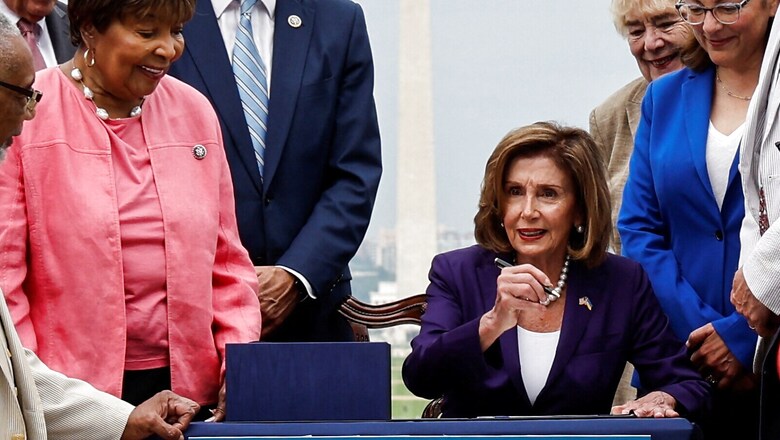
views
Last week, the US Senate decided to advance a bill to promote and support semiconductor chip manufacturing in the country. The bill, known as the CHIPS Act, is an extension to the previous year’s legislation passed by the Senate which approved a $250 billion bill to reinforce US chip-making to compete with the growing clout of China.
With the global chip shortage receding and the production getting back to pre-pandemic levels, the US government pushed the bill through with the intention of improving the manufacturing capabilities of the country in the semiconductor industry. With China running its foundries at full-scale even during the height of the Covid-19 pandemic, the state has managed to slowly increase its market share in the global semiconductor manufacturing ecosystem. The recent Bloomberg report showcases how the last four quarters have been dominated by Chinese semiconductor firms and their operations.
This has raised alarms among the Western states regarding the reduction in influence and market share in the semiconductor domain. But how much can the CHIPS Act achieve the goals and objectives that the US government intends to? Will there be any unintended consequences and unfavourable effects that might arise from the Act itself?
Subsidies to increase manufacturing output?
The recent CHIPS Bill seeks to facilitate the semiconductor manufacturing ecosystem in the country through increased subsidies and financial incentives for the domestic players. Considering the multifaceted benefits of improved chip manufacturing capacity, the US government through the CHIPS Bill looks to provide subsidies worth $52 billion to domestic semiconductor companies.
One of the main reasons behind the advancement of the CHIPS Bill is the aim to reduce the manufacturing dependencies on Asian semiconductor manufacturers and increase domestic manufacturing output. Another objective of the bill is to ensure self-sufficiency in the supply of semiconductor chips in case of another global chip shortage. But can subsidies translate into an increase in manufacturing?
Historically, it’s noticed that in technology sectors, pumping in money and favourable industrial policies cannot always translate into necessary outcomes. This is especially true for the semiconductor industry. The case in point is China itself. The Chinese government has provided a plethora of incentives, subsidies and even financed companies with the hope of improving their semiconductor manufacturing output. However, even its major firm, Semiconductor Manufacturing International Company (SMIC), took over two decades to make a mark in the industry. Currently, it still lags behind industry giants such as Intel and Taiwan Semiconductor Manufacturing Company (TSMC) in the global share.
Though the CHIPS Bill has the potential to positively impact semiconductor manufacturing in the country, the government should not imagine that this would completely insulate the US from supply chain dependencies. This might cover the domestic demand to an extent but international dependency will still remain.
TSMC itself is building a new fab in Arizona looking to branch out from Taiwan. Manufacturing equipment still remains an issue with the need to import certain equipment from abroad.
Also, there is the caveat of the bill stating how semiconductor firms would not be allowed to have any Chinese investments in their company if they benefit from the subsidies provided by the bill. Restrictions over the import and export of semiconductor products to China is also included when availing the benefits of the new legislation.
The CHIPS bill will help spur semiconductor manufacturing in the country and cater to its domestic demand to an extent. But, expecting the bill to help the US attain self-sufficiency in the supply chain remains a futile expectation.
Fab vs Fabless
Another aspect of this legislation is the division of benefits and subsidies. The current CHIPS bill benefits the firms that have the capability to design and manufacture their own semiconductor products. This includes Intel which has the fabrication potential. The bill provides subsidies to build fabrication facilities and provides investment tax credit to purchase tools for use inside their factories.
However, the entire industry is not happy with this. Fabless firms such as NVIDIA, AMD and Qualcomm have expressed disappointment at the legislation. Fabless firms are those semiconductor companies that design their products but outsource their manufacturing to Asian counterparts. The new bill does not have any direct benefits for fabless firms as they do not build foundries or buy equipment.
Such firms have argued this would help just Intel and is more of a rent-seeking opportunity for Intel to dominate the market. Unfair competition between the fab and fabless firms can result in the government choosing winners (in this case, Intel) is what the other companies are saying.
These fabless firms actually support an earlier version of the FABS Act (introduced earlier in the House of Representatives) which provides tax credit on both manufacturing and chip design activities giving benefits to both the type of semiconductor firms. This version of the bill was also supported by the Semiconductor Industry Association (SIA). Though not officially opposing the bill, fabless semiconductor firms have questioned the impact of huge sums of money supporting their competitors.
Finally, the fact that the US has the most number of semiconductor fabrication facilities in the world can also hamper the distribution of the subsidies. Will the financial incentives be proportional to the market share of the company or will it support smaller manufacturers also? These are questions that the bill might have to address before finally getting President Joe Biden’s final signature.
Arjun Gargeyas is a research analyst at Takshashila Institution. The views expressed in this article are those of the author and do not represent the stand of this publication.
Read all the Latest News and Breaking News here

















Comments
0 comment